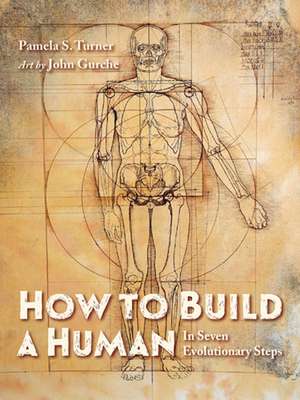How to Build a Human
Autor Pamela S. Turner Ilustrat de John Gurcheen Limba Engleză Hardback – 12 apr 2022 – vârsta până la 14 ani
How did we become who we are? With trademark wit, acclaimed science writer Pamela S. Turner breaks down human evolution into the seven most important steps leading to Homo sapiens. How, when, and why did we:
1.stand up,
2.smash rocks,
3.get swelled heads,
4.take a hike,
5.invent barbecue,
6.start talking (and never shut up), and
7.become storytellers?
This fascinating, wickedly funny account of our evolutionary journey turns science into an irresistible story. Vetted by experts at the Smithsonian's Human Origins Program, the book also features incredibly detailed portraits by celebrated paleo-artist John Gurche that bring our early ancestors to life.
Preț: 131.30 lei
Nou
Puncte Express: 197
Preț estimativ în valută:
25.12€ • 26.30$ • 20.91£
25.12€ • 26.30$ • 20.91£
Carte disponibilă
Livrare economică 10-24 martie
Livrare express 21-27 februarie pentru 43.58 lei
Preluare comenzi: 021 569.72.76
Specificații
ISBN-13: 9781623542504
ISBN-10: 1623542502
Pagini: 176
Dimensiuni: 193 x 257 x 23 mm
Greutate: 0.82 kg
Editura: CHARLESBRIDGE PUBLISHING
ISBN-10: 1623542502
Pagini: 176
Dimensiuni: 193 x 257 x 23 mm
Greutate: 0.82 kg
Editura: CHARLESBRIDGE PUBLISHING
Notă biografică
Pamela S. Turner has a master's degree in public health from the University of California, Berkeley, and an abiding fascination with science, animals, and evolution. She is the author of several award-winning books for young readers, including Samurai Rising, a YALSA Excellence in Nonfiction Award finalist, and Crow Smarts, winner of the AAAS/Subaru SB&F Prize for Excellence in Science Books.
John Gurche is one of the most respected paleo-artists in the field. His works have appeared in National Geographic and Scientific American and at the American Museum of Natural History, the Field Museum of Natural History, and the Smithsonian Institution. www.gurche.com
John Gurche is one of the most respected paleo-artists in the field. His works have appeared in National Geographic and Scientific American and at the American Museum of Natural History, the Field Museum of Natural History, and the Smithsonian Institution. www.gurche.com
